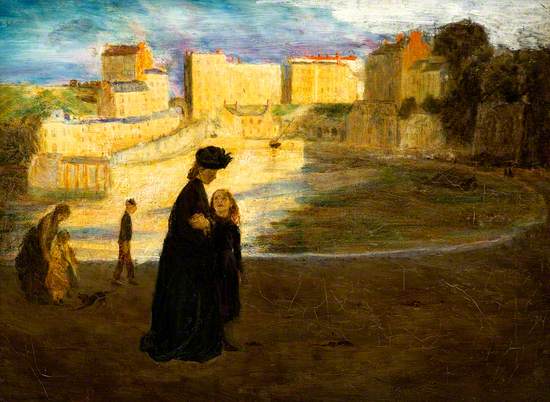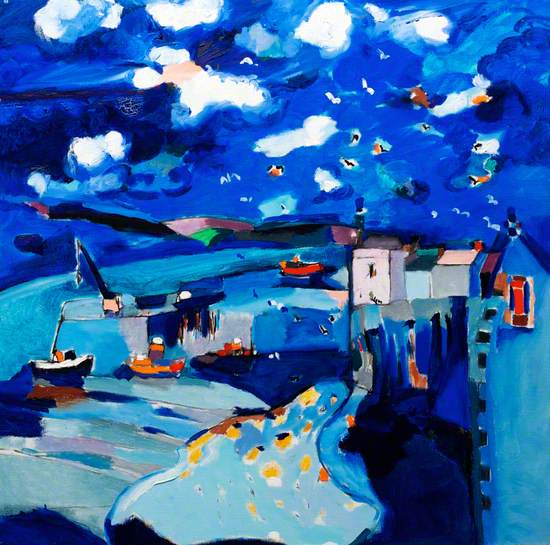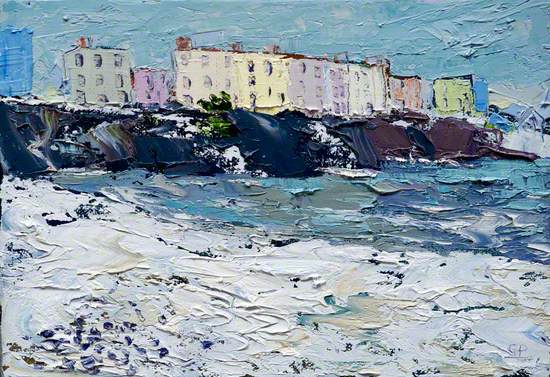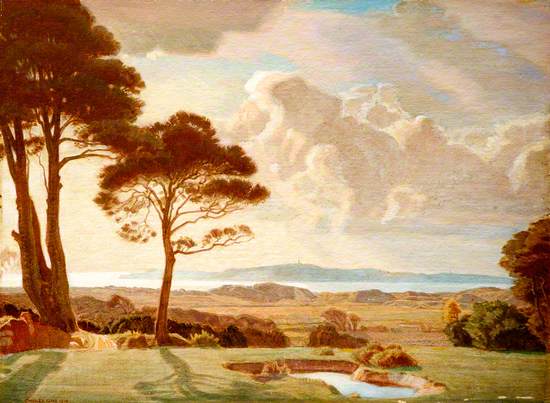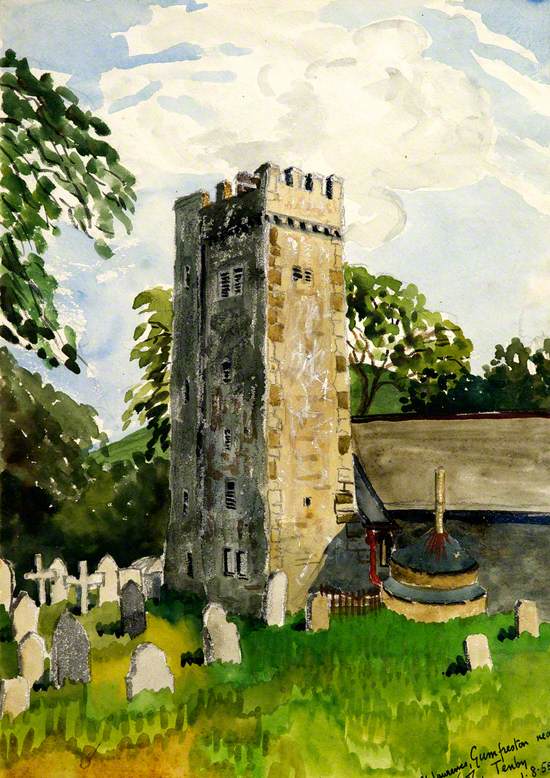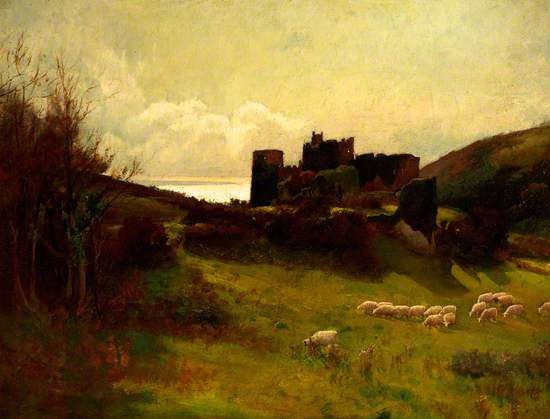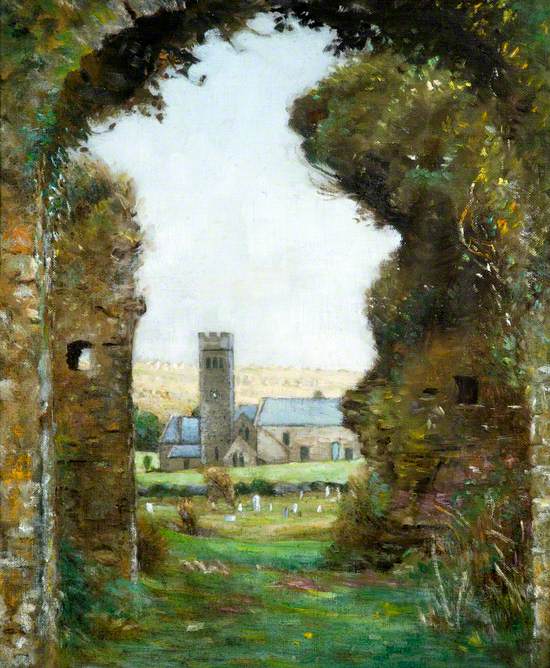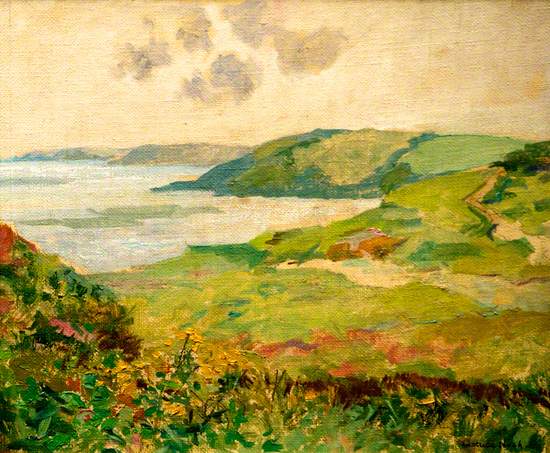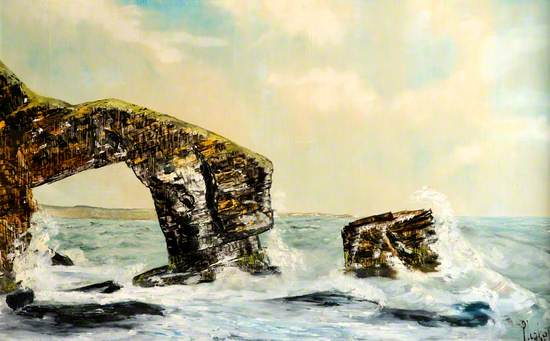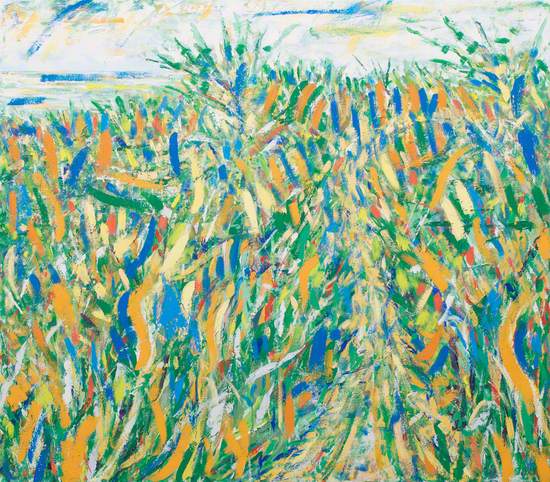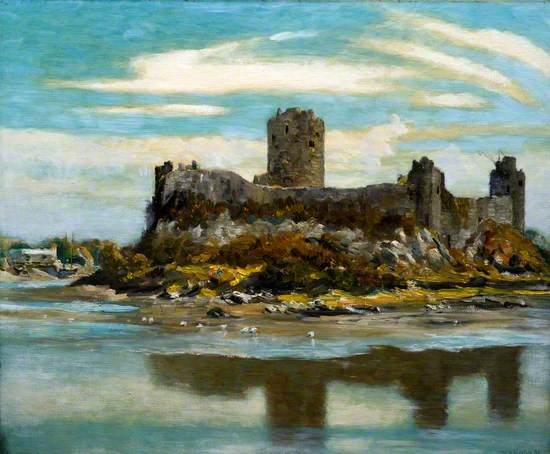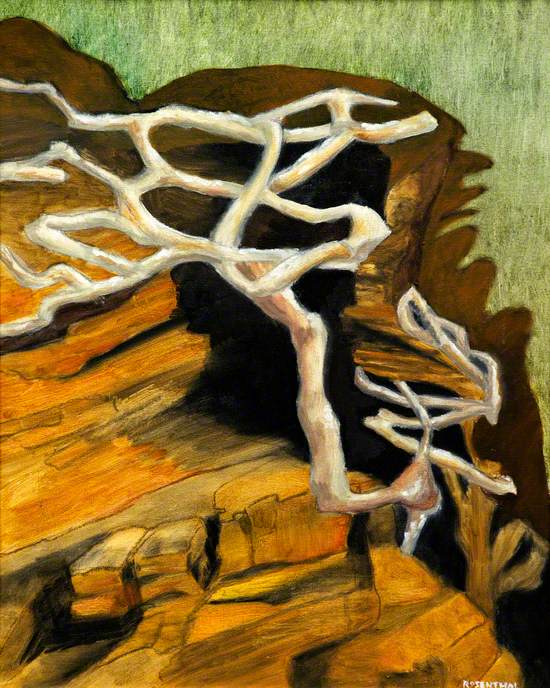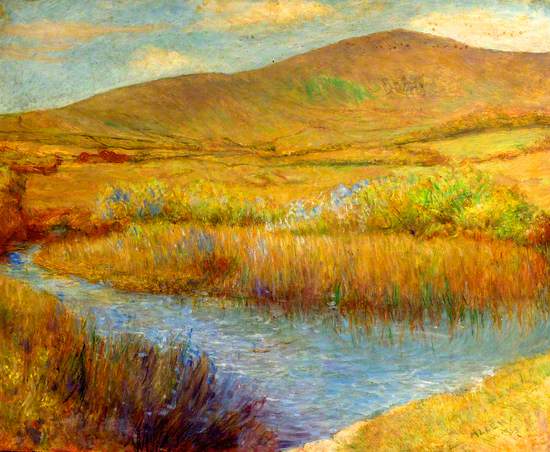Artist Graham Sutherland once stated 'the quality of light here (Pembrokeshire) is magical and transforming'. When one examines the sheer volume of artists who have been drawn here it becomes obvious that Sutherland's observation was not an idle one. Tantalisingly changing with every opportunistic whim of nature, the locality presents itself as something new with every passing moment, all four seasons presented often in one day.
This 'exhibition' is designed to showcase not only the talent of the numerous artists who have painted here but also the transcendent beauty of this magical county.
Landscape at Tenby with Figures
This early work is not a typical Gwen John picture and is almost unique in her oeuvre. It portrays North Beach, the harbour as a backdrop, with several figures including a mother and her children, a dog and a young man in quiet contemplation. A twilight is implied as the sun casts a golden light on the harbour as the shadows fall. At the centre of the picture walk two figures, a young lady in an elegant black coat and a younger girl who gazes up longingly at her companion. The older of the two is Gwen's sister, Winfred, a frequent model in Gwen's work. It is likely that this picture was painted whilst Gwen was at the Slade School of Art. The picture highlights Gwen's fine sense of tone as Whistler described her talent.
Gwen John (1876–1939)
Oil on board
H 46 x W 57 cm
Tenby Museum & Art Gallery
Tenby Harbour
Dan Llywelyn Hall (b.1980)
Oil on canvas
H 57 x W 81 cm
Tenby Museum & Art Gallery
Tenby Harbour, 1989
This picture captures the essence and atmosphere of the harbour through the vivid use of blues combined with splashes of other colours that highlight aspects of the scene.
Philip trained at the Slade School of Art where his stylistic freedom and stunning use of colours swiftly attracted attention. He became a Royal Academician in 1988 and has an international following. When Tenby Museum’s new art gallery opened in 1995 Philip was the first artist to exhibit there. Philip lived in Manorbier for an extended period of time but now he lives in his native county of Dorset.
Philip Sutton (b.1928)
Oil on canvas
H 100 x W 100 cm
Tenby Museum & Art Gallery
The Mayor's Slip
This wonderfully quirky topsy-turvy oil painting, The Mayor's Slip, dates from 1995 and was executed by artist Eric Bradforth. The picture shows the town of Tenby reflected in a pool of water at low tide.
Eric was a wonderful artist - we have several of his works in our collection including his detailed picture of the streets of Tenby in 1586 and his fabulous mural of the town can be seen in Tenby Market - and he was a true supporter of the museum. He sadly died in 2012 and remains much missed.
For those of you familiar with Tenby and its harbour characters, you may well recognise the silhouette of the gentleman in the hat whose shadow is cast on the slope of the slip
Eric Bradforth (1920–2012)
Oil on board
H 59 x W 68 cm
Tenby Museum & Art Gallery
Cresswell Street, Tenby
John Knapp-Fisher was born in 1931 and settled in west Wales in 1965. He had a lifelong love of boats and the sea: he built them, sailed them and later lived aboard one for several years. This is reflected in much of his subject matter, as is the Pembrokeshire landscape, where he lived and worked until his death in 2015, and he is often regarded as one of Wales’principal landscape artists.
He claimed he painted every day, preferring to work from notes and drawings in sketch books. He said, "I tell students to do something every day – even if it’s a quick thumbnail sketch... Rather like a dancer has to practise every day, a painter has to oil the hinges by doing little drawings"
John Knapp-Fisher (1931–2015)
Oil on paper
H 90 x W 83 cm
Tenby Museum & Art Gallery
Snow – South Beach, 2010
Following Sir Kyffin Williams' death in 2006, Gwilym assumed the mantle of senior figure in Welsh landscape painting and was one of Wales’ most admired and successful artists. He was noted for his dramatic, colourful palette, and for applying the paint thickly and expressively as can be seen in this work and he described his approach to work as emotional rather than analytical. Ceri Richards once said that Gwilym Prichard 'painted the bones beneath the land'. In his work he displayed his joy in the richness and beauty of Wales.
Gwilym spent many years in Tenby with his artist wife Claudia Williams. Gwilym sadly died in 2015 aged 84.
Gwilym Prichard (1931–2015)
Oil on canvas
H 27 x W 34.5 cm
Tenby Museum & Art Gallery
Tenby from Waterwynch
In the late 1810s the artist Charles Norris was granted a lease on a plot of land between Saundersfoot and Tenby by the Burgesses of Tenby. One condition of the lease was that he had to build a house costing no less than £200 within 2 years and in 1820 Waterywynch House was built. Norris lived her until his death in 1858. In 1920 the house became the residence of Lord and Lady Ridsdale. The museum has Aurelain Ridsdale's fabulous geological specimens in it collection as well as numerous works in oil and watercolour by Norris; these act as a social, topographical and architectural record of the town prior to photography.
Herbert Charles Goodeve Allen (1878–1965)
Oil on canvas
H 28 x W 38 cm
Tenby Museum & Art Gallery
Caldey from Sunny Mead
Caldey remains on of the only holy islands in Britain. From the Dissolution of the monasteries in 1536 until the 20th century the island had a series of private owners. In 1906 it was bought by a community of Anglican Benedictines who built the present Abbey, restored St David's Church and refurbished the workmen's cottages. Slate roofs were replaced by the distinctive red tiles, now a feature of the island. In 1913 the island converted to Catholicism and in 1925 sold the island to the Cistercian Order, to be occupied by a group of monks from Belgium. The Cistercians took up residence in 1929, re-establishing an historical tradition of Cistercian monasticism in Wales.
Charles March Gere (1869–1957)
Oil on board
H 38 x W 51 cm
Tenby Museum & Art Gallery
St Lawrence, Gumfreston near Tenby
The Church of St Lawrence in the hamlet of Gumfreston is located in a wooded slope that overlooks Tenby in the distance. There are three ancient wells at the bottom of the churchyard which drain into the Rhydeg (Ritec), a narrow waterway that flows into the sea. The wells are thought to pre-date the church which dates form its earliest part to the 12th-13th centuries. Internally there is a wall painting believed to be St Lawrence. The church was restored in 1869 by architect Thomas Graham Jackson. Interestingly one previous rector of the Gumfreston, Gilbert Smith, was also and amateur archaeologist and his finds formed the basis of Tenby Museum's collection when it first opened inn 1878..
Eric Trayler Cook (1893–1978)
Oil on board
H 35.7 x W 26 cm
Tenby Museum & Art Gallery
St Florence Church near Tenby
The 12th century parish church is dedicated to St Florentius and is first mentioned in 1248. A mortuary chapel was added in the 15th century and the church underwent two restorations in the 19th century under Rev. G.W. Birkett. Further restoration was undertaken in 1963. It is now a grade II listed building. In the church is a memorial to Robert Farrar, the Protestant Bishop of St David's who was burned at the stake in Carmarthen during the reign of Mary in 1555.
Eric Trayler Cook (1893–1978)
Oil on board
H 21.5 x W 26.5 cm
Tenby Museum & Art Gallery
Manorbier Castle
Manorbier Castle was built at the end of the 11th century on land granted to the Norman Knight Odo de Barri. His son William began work on the stone fortification in the early part of the 12th century. Here the famous Welsh scholar and ecclesiast, Gerald de Barri, (Gerald of Wales or Giraldus Cambrensis) was born in circa 1146.
It was sold off by the Crown in 1630, being described as "quite decayed." It was renovated in the 19th century.
The renowned poet Siegfried Sassoon wrote a poem about the castle, A Ruined Castle, in 1924 whilst staying with poet Walter De La Mere. Virginia Woolf is alleged to have been inspired to become a writer whilst on a walk along the beach here.
Edward Joseph Head (1863–1937)
Oil on canvas
H 70 x W 105 cm
Tenby Museum & Art Gallery
Manorbier Church
In the 6th century a Celtic monastery was established by St Pyr on a hillside at Manorbier. The saint gave his name to the location - Manorbier derives from the Welsh for belonging to Pyr. St Pyr was also the first abbot of the monastery on Caldey Island - the Welsh name for Caldey is Ynys Byr or Pyr's Island
In the middle of the 12th century a Norman church was built on part of the earlier monastic site. By then Manorbier Castle had been built on the opposite hillside. The oldest part of the church dates form the 12th century. It was restored in the Victorian and Edwardian periods where a series of excellent stained glass windows wee installed showing work by some of the finest craftsmen of the time.
William Augustus Rixon (1858–1948)
Oil on canvas
H 49.5 x W 42.5 cm
Tenby Museum & Art Gallery
Manorbier Bay
Eustace Pain Elliott Nash (1886–1969)
Oil on board
H 34 x W 39 cm
Tenby Museum & Art Gallery
Green Bridge (Stack Rocks)
The Green Bridge of Wales is a natural arch of carboniferous limestone on the southern Castlemartin peninsula. Erosion has occurred over many years as the winds, pebbles and sand particles have battered the coastline and dissolved the limestone in the weakest parts where there are folds and faults. Erosion has formed caves which extended further until they met, forming the arch that can be seen today. The bridge is about 24m (80 ft) high with a span of more than 20m (60 ft). Its outer edge rests on a more durable rock pedestal. The Green Bridge lost a considerable amount of rock damage during Storm Ophelia in 2017.
Brendan S. Plunkett
Oil on board
H 53.5 x W 80 cm
Tenby Museum & Art Gallery
Skrinkle
Beautiful Skrinkle beach lies between Lydstep and Manorbier.
Upon the death of his grandfather, who left him his art materials, when the artist was 11 years old, Burton-Richardson started to paint in oils on a serious basis. To see that box of oil paints and brushes was like a child opening a box of sweets, he said. Recent works have been more sombre and melancholic in colour and mood, with the emphasis being on the darker side of life as opposed to the natural beauties and colour of the natural world.
David Burton-Richardson (b.1961)
Acrylic on canvas
H 106 x W 120.7 cm
Tenby Museum & Art Gallery
Pembrokeshire Corner, Hodgeston
Eric Bradforth was born in Sheffield in 1920. He trained at Sheffield College of Art and the Royal College of Art, London. He was asked to develop a Graphic Arts Department for the Royal Artillery based at Manorbier. His graphic arts background is evident in much of his work which features closely-observed detail. Eric developed an abiding affection for Pembrokeshire, having moved his family here in 1950. His work can be seen in various paces in Tenby including a mural in the town market and several works in the museum. He died in 2012.
Eric Bradforth (1920–2012)
Oil on board
H 52 x W 70 cm
Tenby Museum & Art Gallery
Pembroke Castle
Pembroke Castle has a long and fascinating history- around 1093 Arnulf de Montgomery built the small inner bailey standing at the end of the promontory.
Only a few years later the castle withstood a long siege by the Welsh, although its defenders were near starvation.
Pembroke is also noteworthy as the only castle in Britain to be built over a natural cavern, a large cave known as the Wogan. Historically, Pembroke is important not only for its architecture but for the fact the Harri Tudur, who became Henry VII and began the long line of Tudor monarchs, was born there in 1457, reputedly in the tower now known as the Henry VII Tower.
William Augustus Rixon (1858–1948)
Oil on board
H 50 x W 60 cm
Tenby Museum & Art Gallery
St David's
Stan was born in London but lived in Pembrokeshire for many years. Later in life ill health forced him to move away but at the age of 78 he reminisced in the Western Mail “If it wasn’t for my health, I’d still be living there. I miss the colour, the way the light changes so quickly just as the weather changes, and I miss the hywl. “
He credited Pembrokeshire with helping him find his unique voice as a painter: “Pembrokeshire has light bouncing off the sea on two sides and that increase in light gives everything an additional brightness. My work definitely became more colourful when I moved to Pembrokeshire: it was a reflection of the fact that colours really are brighter.”
Stan Rosenthal (1933–2012)
Oil & gouache on canvas
H 67 x W 57 cm
Tenby Museum & Art Gallery
View of St David's
Grahame is one of the most exciting painters working in Pembrokeshire at the moment. His frequently large canvases, painted predominantly in oils, are filled with vibrancy and colour and more often than not concentrated around the St David’s area, which has been his home since 1984. In 2013 he started the massive task of painting a portrait of every resident in the city of St David’s. We have been lucky at Tenby Museum to have hosted exhibitions by Grahame on several occasions.
Grahame Fergus Hurd-Wood (b.1956)
Oil on canvas
H 58 x W 109 cm
Tenby Museum & Art Gallery
.
Moment of Perception
This painting shows an unidentified landscape, but it is highly likely to be one of the Pembrokeshire islands. Since 1949 Ray had lived in West London but each summer she made a pilgrimage to the Pembrokeshire Coast, around St Martin’s Haven and Skomer Island, to write and paint. It is probable that this picture, dated 1967, was undertaken on one such pilgrimage. Within the seclusion of these islands she was inspired by the ever-changing landscape, rich bird life and the craggy rock formations.
She was one of the few women to become an accredited War Artist, recording the coastal defences of South Wales and the D-day preparations around Cardiff Docks. She died in 1996, aged 93.
Ray Howard-Jones (1903–1996)
Oil on canvas
H 65.5 x W 91 cm
Tenby Museum & Art Gallery
Preselly's
An article in the Tenby Observer reported on Herbert Allen: “’I swopped a stamp album for my first box of paints,’ says Major Herbert Allen, Saundersfoot’s talented artist…’Who did I swop with? My old school friend, Augustus John…Yes, the great painter and myself were at school together. And strangely enough, in those days, it was I who was the serious artist. He did not pay such a great deal of attention to it then.”(8 September 1950).
He also reported that it took him on average two to three afternoons to complete a picture, “But one cannot work for more then 3 ½ hours because of the changing light.”
Herbert Charles Goodeve Allen (1878–1965)
Oil on board
H 78 x W 88 cm
Tenby Museum & Art Gallery
Explore artists in this Curation
View all 17-
 Ray Howard-Jones (1903–1996)
Ray Howard-Jones (1903–1996) -
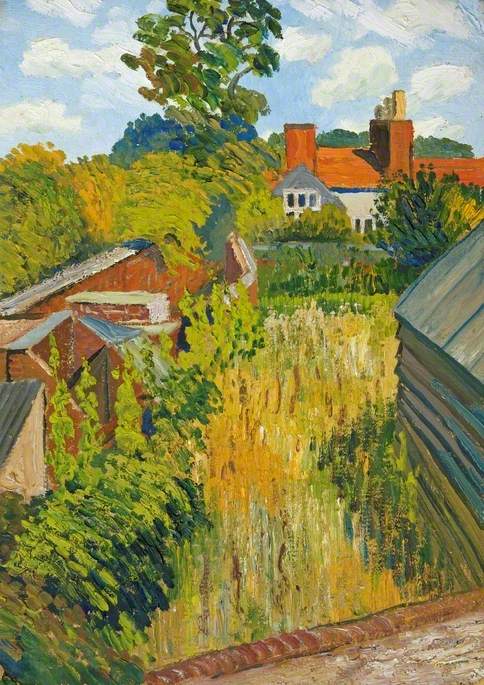 Eric Trayler Cook (1893–1978)
Eric Trayler Cook (1893–1978) -
 Grahame Fergus Hurd-Wood (b.1956)
Grahame Fergus Hurd-Wood (b.1956) -
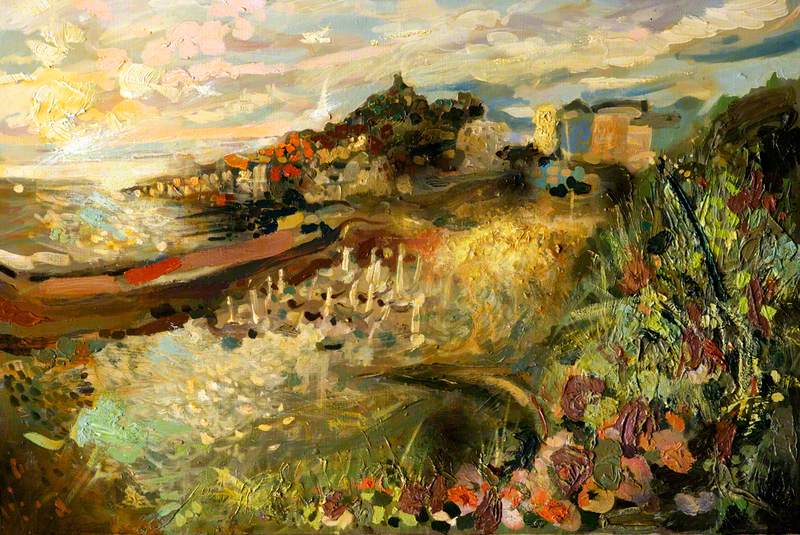 Dan Llywelyn Hall (b.1980)
Dan Llywelyn Hall (b.1980) -
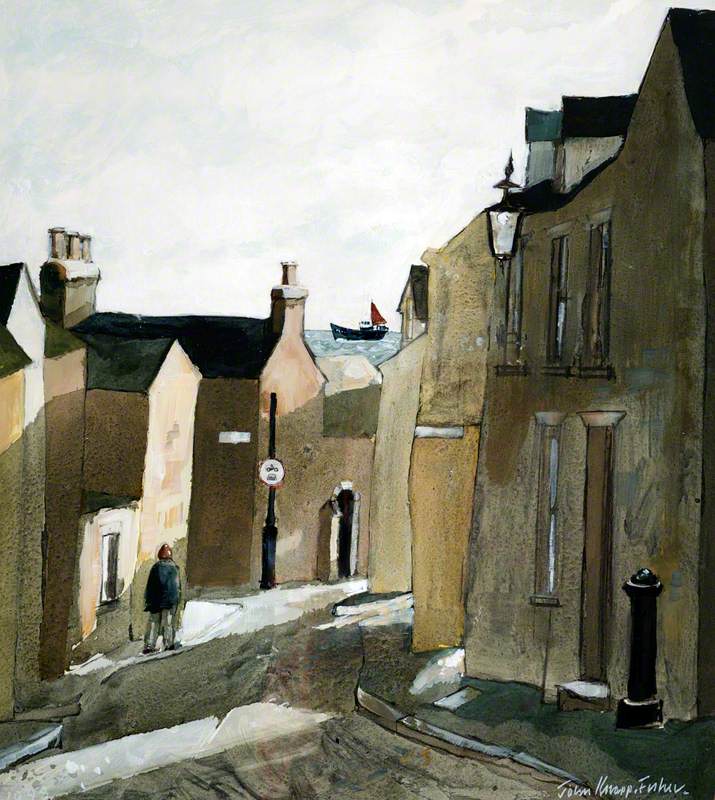 John Knapp-Fisher (1931–2015)
John Knapp-Fisher (1931–2015) -
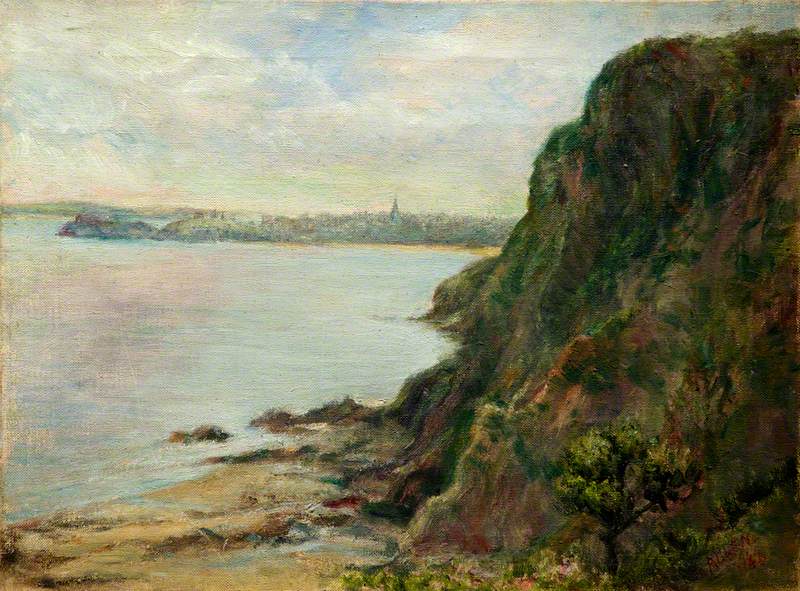 Herbert Charles Goodeve Allen (1878–1965)
Herbert Charles Goodeve Allen (1878–1965) -
 Eustace Pain Elliott Nash (1886–1969)
Eustace Pain Elliott Nash (1886–1969) -
 Gwen John (1876–1939)
Gwen John (1876–1939) -
 Charles March Gere (1869–1957)
Charles March Gere (1869–1957) -
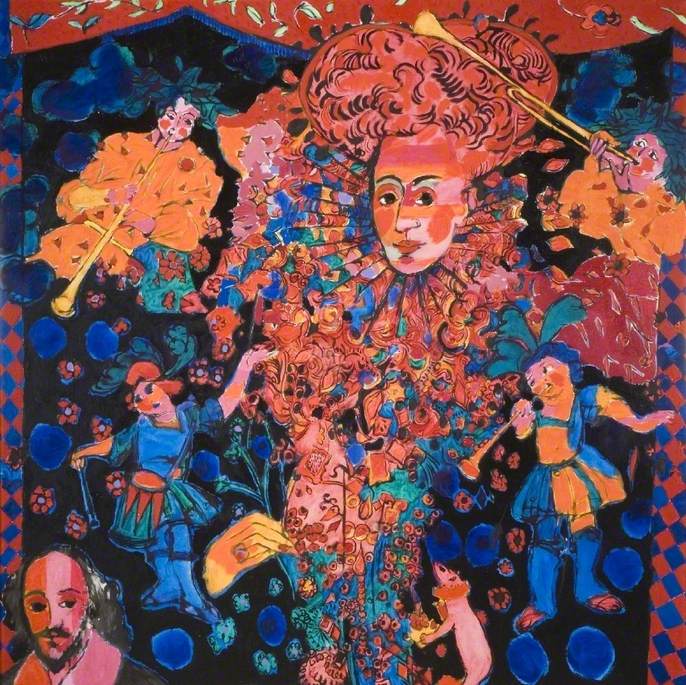 Philip Sutton (b.1928)
Philip Sutton (b.1928) - View all 17
